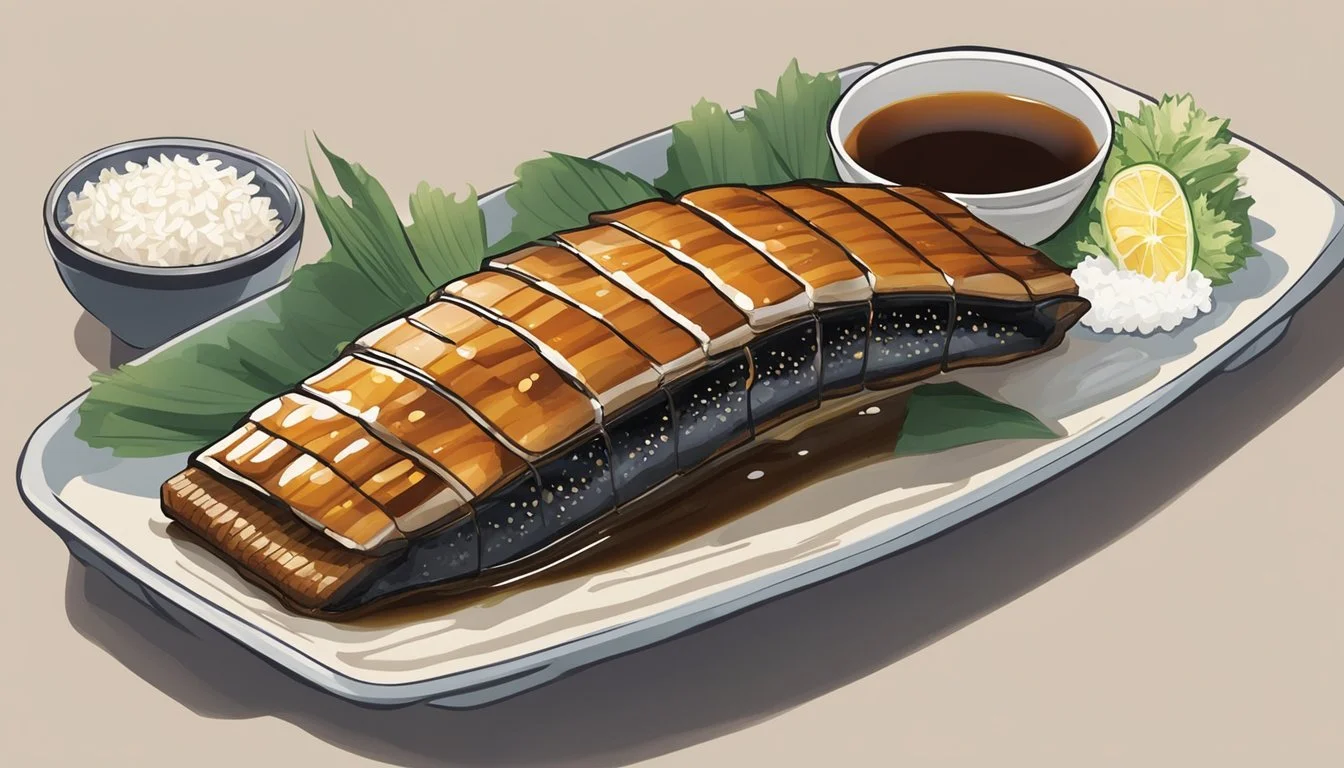How do You Eat Unagi
A Guide to Enjoying Eel the Right Way
Unagi, the Japanese term for freshwater eel, is a delicacy that boasts a rich and bold flavor. This elongated fatty fish is distinct from its saltwater cousin, anago, and plays a prominent role in Asian cuisines. Unagi is never eaten raw due to the presence of toxins in eel blood which can be harmful if ingested. To render it safe and enhance its flavor, the eel is usually cooked through methods such as broiling, grilling, or pan-frying.
When preparing unagi, a common Japanese method called kabayaki is often employed. This entails splitting the fish down the back, gutting, deboning, butterflying, and cutting it into squares. The eel is then skewered and typically dipped in a sweetened soy-based sauce before being broiled or grilled. The result is a savory and slightly caramelized exterior with a tender, moist interior. Traditionally, unagi can be served on a bed of steamed rice as in unagidon or used as a key ingredient in sushi (What wine goes well with sushi?) rolls known as unakyu.
Culinary customs in Japan include consuming unagi as a way to gain stamina during the hot summer months, particularly on a special day known as 'doyō-no ushi-no-hi'. This practice, dating back to the Edo Period, reflects the cultural and historical significance of unagi in Japanese food (What wine goes well with Japanese food?) traditions. Whether enjoyed in a luxurious restaurant or at home, the enjoyment of unagi is deeply rooted in Japanese cuisine, offering a delightful experience to both locals and gastronomes around the world.
Understanding Unagi
Unagi is the Japanese term for freshwater eel, specifically Anguilla japonica, a species prevalent in Japanese cuisine. Contrary to American eel, European eel, and the longfin eel, the Japanese eel has developed a significant cultural and culinary importance in Japan.
Freshwater eels, including unagi, are traditionally prepared through a cooking process known as kabayaki. This method involves splitting the eels down the back, deboning, and cutting them into fillets. The eels are then skewered, basted with a sweet soy sauce-based marinade called tare, and finally broiled or grilled.
Preparation Technique Details Kabayaki A traditional grilling method Tare Sweetened soy-based sauce Presentation Served over rice or in sushi
Unagi is distinctly different from its saltwater relative, anago, in both habitat and flavor. Eel must be cooked as their blood contains toxins; consuming raw eel can be extremely harmful. Commonly, unagi is enjoyed for its rich flavor and is said to increase stamina.
The demand for unagi has unfortunately contributed to overfishing, placing it on the list of endangered species. Sustainable practices and farm-raising alternatives are growing in importance to mitigate these effects. Organizations like Seafood Watch in the United States advocate for responsible consumption by recommending eel from sources that minimize environmental impact.
Unagi in Japanese Cuisine
In the diverse world of Japanese cuisine, unagi, or freshwater eel, stands out for its distinctive taste and preparation methods. Unagi no kabayaki is a traditional dish where the eel is filleted, skewered, and grilled with a glaze of sweetened soy-based sauce, creating a rich flavor profile that is both bold and delicate. This method of preparation is so entrenched in the culinary landscape that specialized restaurants, known as unagiya, have gained repute, particularly in cities like Tokyo, Nagoya, and Hamamatsu.
Unagi's versatility in Japanese dishes is evident from its inclusion in various forms:
Unadon: A simple yet flavorful dish where grilled eel is served atop a bowl of steamed rice.
Unaju: Similar to unadon but presented in a lacquered box, offering a more aesthetic dining experience.
Shirayaki: Eel is grilled without the tare sauce, allowing its natural flavors to shine through.
In sushi cuisine, unagi can be found in nigiri sushi, where a slice of eel is draped over a small mound of vinegared rice, and in umaki, a variation of sushi rolls filled with eel. In some cases, tempura batter may also be utilized to add a crisp texture to the eel, providing a contrast to the usual softness.
Regional specialties also influence how unagi is consumed. For example, the Nihonbashi district of Tokyo is noted for its longstanding establishments like Hashimoto, where unagi is prepared meticulously through traditional methods.
The nutritional content of unagi, rich in vitamins and minerals, has led to its reputation as a beneficial food during the hotter months, tying into Japan's seasonal culinary traditions. Moreover, unagi finds its way into soups such as kimosui, a soup made with eel liver, which is considered a delicacy.
In summary, unagi plays a significant and varied role in Japanese cuisine, featuring in a multitude of dishes that highlight the culture's culinary finesse.
Preparation and Cooking Techniques
Mastering the preparation and cooking of unagi, or freshwater eel, involves specific techniques to enhance its natural flavors and achieve the right texture. This section sheds light on the traditional and modern methods that bring out the best in unagi dishes.
Cleaning and Filleting
To prepare unagi, it is first split down the back, gutted, and deboned. The eel is then butterflied to lay flat and usually cut into square portions. Ensuring the eel is properly cleaned and filleted is essential for both texture and flavor.
Grilling Methods
Traditionally, filleted unagi is skewered and grilled. Charcoal grilling is preferred for its subtle smokiness. Unagi can be cooked by broiling, which caramelizes its outer layer, giving it a savory taste and an appealing texture.
Seasoning and Flavors
A sweet basting sauce, often a mixture of soy sauce, mirin, sugar, and sake, is prepared to flavor the eel. As it grills, the unagi is repeatedly dipped in this savory sauce, enhancing the sweet flavor and creating a glossy finish. Salt may also be used for simpler seasoning.
Serving Styles
Grilled unagi is prominently featured in Japanese cuisine and can be served in different styles. Unadon, a bowl of steamed rice with unagi on top, and unakyu, a sushi variety, are popular. In a more celebratory form, jubako, resembling lacquered boxes, may contain layers of rice and unagi, known as hitsumabushi.
Storage and Reuse
Leftover unagi should be stored properly, often vacuum-sealed and frozen to extend shelf life. It can be thawed and reheated, usually by grilling or steaming, without significant loss of flavor or texture.
Unagi Alternatives
When unagi is not available, anago, or saltwater eel, is a common substitute. Anago is usually lighter in taste and can be prepared similarly to unagi, grilled with a sweet sauce.
Health and Nutrition
Unagi is rich in protein, calcium, vitamin A, and minerals. Due to its fat content, it supplies a high calorie count which traditionally associates with increased stamina, particularly favored as a summer food.
Cultural Significance
Unagi has a historical cultural significance in Japan, often enjoyed on the Day of the Ox, believed to bring strength during the hot summer months. It is a classic element of Japanese cooking.
Sustainability and Conservation
Freshwater eel, especially Anguilla japonica, has seen declining populations due to overfishing. It's important to consider sustainability and choose eel from sources that practice responsible conservation efforts, noted by organizations like Seafood Watch.
Selecting and Purchasing
When buying unagi, look for a firm texture and a pleasant, fresh smell without a fishy aftertaste. It is often sold pre-cooked and ready-to-use in vacuum-sealed packages, making it a convenient option for home preparation.
Dining Etiquette
In Japanese dining etiquette, unagi is typically enjoyed with steamed white rice and condiments such as wasabi and soy sauce. Nigiri sushi featuring a piece of cooked eel on top is eaten in one or two bites.
Historical and Regional Variations
Over time, regional variations of unagi dishes have developed, reflecting local preferences and cooking styles. Each region in Japan may have its own distinctive way of preparing and serving eel, based on historical influences and available ingredients.
Conclusion
Enjoying unagi goes beyond just eating a meal; it's a culinary experience steeped in tradition and craft. From its precise preparation to the carefully tuned flavors, unagi dishes reflect the depth and sophistication of Japanese cuisine.



